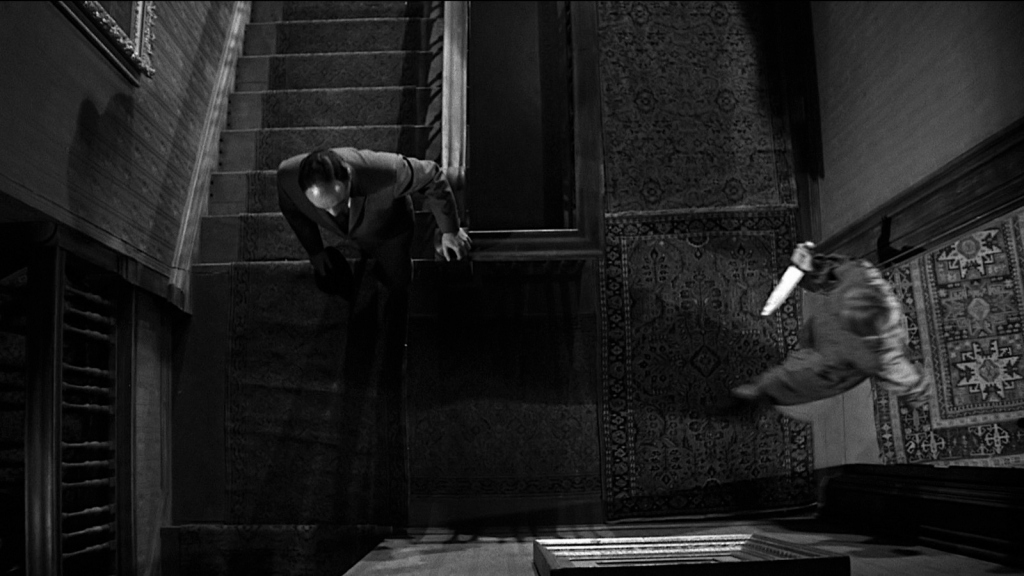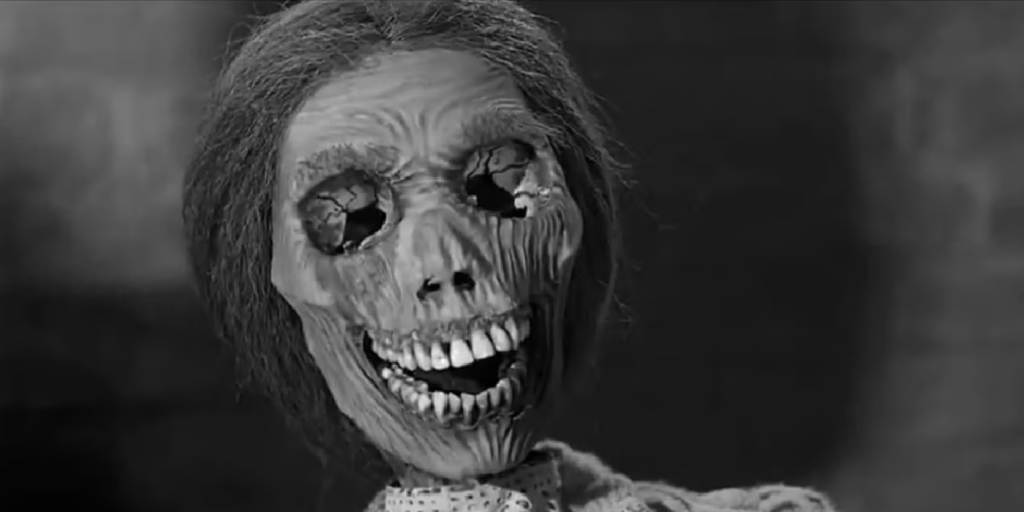I was in high school when some friends suggested we go see a late night showing of Psycho at our local art house theater. At that point in my life, I had decided to be a filmmaker and I was watching a lot of movies, mostly new releases, but I was slowly making my way through the classics. I wasn’t a fan of horror. In fact, I had gone out of my way to avoid it, but I was excited to be with the group and they assured me I would be OK.
Psycho wasn’t my first Alfred Hitchcock film, that was The Birds, which we watched in middle school after reading the short story, thus ensuring my trepidation about birds to this day. Psycho seemed like the scarier of the two just based on subject matter. Though, I felt a little more comfortable with Psycho because it is indelible to the cultural lexicon. I, like most people, had seen parodies or pieces of the famous shower scene. It’s everywhere from cartoons to sitcoms to comedic movies. One of the best is in Mel Brooks’ send up of all things Hitchcock, High Anxiety. As much as I knew the scene I also knew the music cue. It comes up just as much as the scene and often in different contexts, but with the same intention, to evoke a sense of fear.

Making the film, as detailed in Stephen Rebello’s book “Alfred Hitchcock and the Making of Psycho,” Hitchcock and the rest of the crew viewed the shower scene as the centerpiece of the film. The amount of detail, the complicated covering of body parts, and by today’s standards a paltry amount of blood was necessary to give the audience a shock. Add in that truly iconic score by Bernard Herrmann and it’s a classic and indelible scene for a reason.
Seeing the film for the first time, you assume that Marion Crane (Janet Leigh) will be the heroine for the whole film. Even with the knowledge of the shower scene and knowing it’s Marion getting murdered, you may assume that that sequence occurs at the end of the film. It would just make sense for the main character to not be the first body to drop. Though, knowing that Marion will be killed is not the point of the film. That tension of knowing Marion’s fate isn’t Hitchcock’s, screenwriter Joseph Stefano, or original novelist Robert Bloch’s intention. They would prefer you to go in blind.
Yet, for me on that fateful night, I did know about that scene. I experienced constant anxiety that an entire killer and victim game would be played out while knowing that Marion didn’t have a happy ending. What I never predicted, and what that scene out of context never prepares you for, is that after you jump in your seat when that music cue hits, you have the majority of the film left to watch.

There’s a calm as Norman Bates (Anthony Perkins) cleans up after Mother’s murder in utter silence. It’s a strange phenomenon to watch his entire thought process play out. You expect him to be caught. You expect him to find the money. None of that happens, though. It’s as if it happened in reality without the time shift a film like this usually has. This changes how you view the film, especially for the first time.
The murder you’ve anticipated, the one that you’re frightened by is over. So now what? What could top this scene that has been in the hearts and minds of people for 65 years? Now Hitchcock keeps you on your toes.
This calm, languid period is to lull you into a false sense that this film will simply become a type of noir. This final two acts of film has its own private detective, Milton Arbogast (Martin Balsam). It has a concerned couple in Marion’s sister Lila (Vera Miles) and Marion’s boyfriend Sam (John Gavin). This detective story is the end. It’s the final nail in Mother’s coffin because the detective always gets his perpetrator. Nothing can happen that can top the shower scene. In my mind, as I watched it that first time and felt my heartbeat steady and my worry that the shower scene was all Psycho had to offer, I figured Psycho was a gimmick film. It was a film with one great set piece and little else. That is until Arbogast enters the Bates home.

Arbogast’s looking for proof of Marion or at least to attempt to talk with Mrs. Bates (voiced at different times by Virginia Gregg, Paul Jasmin, and Jeanette Nolan). This is when we know something else will happen. Editor George Tomasini inserts several shots of Arbogast ascending the stairs. A foot on the step and a hand on the railing, then a head cresting the top of the landing, but there’s something else there, too. There’s a light behind a door that’s slightly ajar. That door creaks open a little more. That’s when cinematographer John L. Russell’s camera is suddenly in an overhead shot and with a terrifying silence, Mother shoots out of a room, knife raised and she brings it down, slashing through Arbogast’s face. Arbogast’s look of terror, mixed with the rear projection of the floor at the foot of the stairs coming up behind him, and the uncredited foley artist’s horrifying sounds of Arbogast attempting to get his feet underneath him, climax with him landing on the first floor on his back. Mother is on him in seconds to pierce him twice as he screams.
This sequence, while not as famous, is the real trick of Psycho. The first murder makes sense, the second is an utter shock. It simply terrified me that first time in the theater. I nearly stood up to cower away. It alarmed me so much. It’s that effective of a scene. While we know Arbogast is in danger when he goes into the house, we can’t know that he is at such a disadvantage. He’s not even close to a match for Mother’s cunning and we’re not prepared for Hitchcock’s second feat of daring filmmaking. The shower scene gets a lot of credit, and rightly so, but this scene is just as impeccable and just as shocking in its execution. That’s when we realize it’s been Mother’s story all along.
The psychological explanation at the end of the film for why Norman may have taken on the personality and persona of Mother is pop psychology. Even as it makes movie sense for Norman and the inspiration for Norman, real life killer Ed Gein, Norman’s cross dressing is not easily defined. While someone blurts out the word transvestite during Dr. Richman’s (Simon Oakland) explanation of Norman’s psychology, Dr. Richman balks at the notion and declares that Norman is much more disturbed.

We can take this in a couple of different ways, but it’s obvious that there is an equality in Dr. Richman’s mind between Norman’s mental illness and his gender dysphoria. Dr. Richman believes that Norman’s queerness is just another symptom of that mental illness. It has been that way in film since the advent of the Hays Code. Queerness and queer people are bad. Even in previous Hitchcock films, these characters are antagonists. Characters like Brandon (John Dall) and Phillip (Farley Granger) in Rope, Bruno (Robert Walker) in Strangers on a Train, Mrs. Danvers (Judith Anderson) in Rebecca, or Leonard (Martin Landau) in North by Northwest are all queer coded and are all proven to be amoral in some way, their queerness just another factor in why they commit evil. This isn’t to defend Norman’s actions when he is dressed as Mother, but to say that Norman’s need to kill Marion and Arbogast wasn’t because he’s queer. Norman’s queerness isn’t evil, but it is a part of him that others wrongly perceive as evil.
As the credits rolled on that screening I went to, I couldn’t slow down my heart beat. I could barely catch my breath. My friends were giddy and excited by my terror and my elation. Even as the film struck at the core of my fear and anxiety, I knew I had to see it again. In the many times I’ve seen it since, there is still a quickening of my pulse as Marion starts the shower and Arbogast begins his ascent up the stairs. There’s even more anxiety as I anticipate Norman’s sly smile at the end, which my friend Adam, who had the same build and stature as Anthony Perkins, delighted in recreating on the dark drive home.
Psycho is a classic not just because it’s a great Hitchcock film, but because it helped to build and mold the ideas of modern horror. The film is a blueprint for how to shock, scare, and titillate an audience. It is beloved because it shows us not monsters in rubber masks, but the banality of the true killers that walk amongst us. They can be anyone and they can get to anyone and for a while they may even get away with it too.





